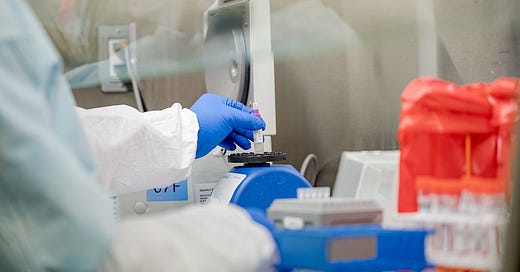Debate over the possibility of a COVID-19 lab leak is over
It is now overdue to appropriately investigate that possibility
A lot has happened in the past few weeks in the ongoing debate over the possibility that COVID-19 was the result of a research-related incident – more generally known as the “lab leak hypothesis.” While we may never have full certainty on the origins of COVID-19, this post documents that it is now well established that a lab leak origin is a possibility. Let me run down a few recent updates based on four new preprints published in the past few weeks.
First, a new analysis of the presence of SARS-CoV-2 at the Huanan Seafood was equivocal on origins. Instead, the team of 38 researchers in China, led by George Gao -- Director of the Chinese Center for Disease Control and Prevention and Dean of the Savaid Medical School of the University of Chinese Academy of Sciences – concluded in their new preprint that the market could have served as a location where the disease rapidly spread:
[T]he market might have acted as an amplifier due to the high number of visitors every day, causing many initially identified infection clusters in the early stage of the outbreak as indicated in the Report of WHO-convened global study of origins of SARS-CoV-2. In addition, live SARS-CoV-2 viruses also existed in the environmental samples. However, no SARS-CoV-2 was detected in the animal samples from the market.
The very next day two more preprints were published analyzing data on early COVID-19 cases in Wuhan by scientists outside of China. One preprint, led by Michael Worobey of the University of Arizona and Kristian Anderson of the Scripps Research Institute, joined by 16 co-authors, claimed that their work meant case closed — claiming that their “analyses provide dispositive evidence for the emergence of SARS-CoV-2 via the live wildlife trade and identify the Huanan market as the unambiguous epicenter of the COVID-19 pandemic.”
Another preprint, led by Jonathan Pekar at the University of California San Diego, claimed that two different animals passed two different strains of SARS-CoV-2 to two different people at the Huanan Market, at two different times: “these two lineages were the result of at least two separate cross-species transmission events into humans.”
This brings us to the fourth new preprint, by Virginie Courtier-Orgogozo of the University of Paris and Francisco A. de Ribera of the Universidad Pontificia Comillas in Spain, published one day after the previous two preprints. (If you get the sense that preprints are published in response to other preprints, then you are probably correct!). Their analysis of the available data from the Huanan Market lead them to hypothesize, “based on the spatial and temporal distribution of initial positive cases at the market, we suggest that several early infections at the Huanan Market may have occurred via human-to-human transmission, presumably in closed spaces.”
As you might expect, these new studies have been much discussed and debated, fortunately in public via Twitter. Here are my initial interpretations of these new papers:
Any analysis of data from the Huanan Market will be shaped by the protocol used to collect the data in the first place. I am no virologist but I can read pretty well. Thanks to a tip from Alina Chan it appears that data collected by the WHO as part of its initial origins committee screened data collection based on exposure to the Huanan Market, as you can see in the screenshot below. To the extent that this screening was actually the case, significant and obvious biases can be introduced into the results based on screened data.
On the idea that there were two separate animal-to-human transmissions of SARS-CoV-2 weeks apart in the same market, I find the response of German virologist Alexander Kekulé to be compelling:
One does not need to be a virologist to see that this is a bit comical. Two independent jump events, what Worobey gives us as explanation for this pandemic, means that within a few weeks two fully independent animals were by some coincidence sold at the same time in the same market, were infected by two fully independent virus clades, and both managed in that short time to infect each at least one human, who then both started a wave of infections. Well that did not happen over the previous 30 years, rather funnily. And in this case it did not happen either. (H/T Giles Demaneuf for the link and the translation).
My view is that the search for the origins of COVID-19 remains as open as ever. The back and forth between convinced natural origins advocates and lab leak proponents — even with over-the-top claims and misleading reporting — has been incredibly enlightening to a non-expert like me. May it long continue.
But don’t take my word that the debate over the possibility of a lab leak is now settled. In February 2020, soon after COVD-19 began spreading around the world, Peter Daszak of EcoHealth Alliance orchestrated a letter signed on to by 26 other scientist, published in The Lancet, “to strongly condemn conspiracy theories suggesting that COVID-19 does not have a natural origin.”
But in an interview with The Intercept published late last week, Daszak offered a quite different opinion, “Do I agree that it’s possible that Covid-19 emerged through a lab leak? Of course.”
The debate over the possibility of a lab leak is now over. Let’s now focus on appropriately exploring that possibility.






It is interesting how the Lancet seems to be at the center of a scandal very frequently in recent years. It seems like they are determined to lose their status as one of the most prestigious journals in the world in their rush to virtue signal and be on the 'correct' side of every issue.
Just for clarification, the debate over whether Covid leaked from the lab is separate from the debate that Covid was engineered or modified in the lab, correct?